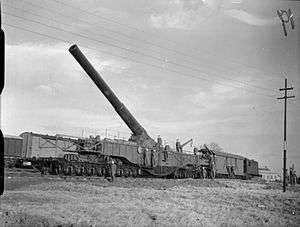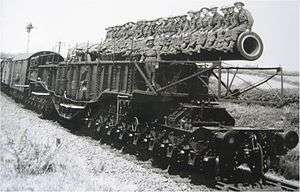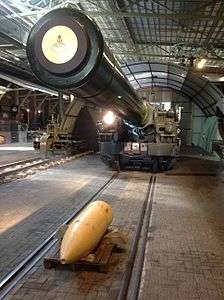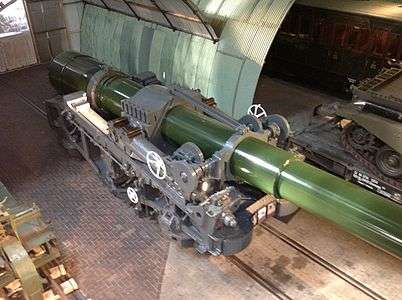BL 18 inch railway howitzer
| BL 18 inch railway howitzer | |
|---|---|
 Example at Catterick, 12 December 1940 | |
| Type | Railway howitzer |
| Place of origin | United Kingdom |
| Service history | |
| In service | 1920 - 1945 |
| Used by | United Kingdom |
| Wars | World War II |
| Production history | |
| Manufacturer | Elswick Ordnance Company |
| No. built | 5 |
| Specifications | |
| Weight | 85.7 tons (barrel & breech) |
| Barrel length | Bore: 52 ft (16 m) (34.7 calibres)[1] |
|
| |
| Shell | HE; 2,500 lb (1,134 kg)[1] |
| Calibre | 18-inch (457.2 mm) |
| Elevation | 0° - 40° |
| Traverse | 2° L & R |
| Muzzle velocity | 1,880 ft/s (570 m/s)[1] |
| Effective firing range | 22,300 yd (20,400 m)[1] |
The BL 18 inch railway howitzer (formally Ordnance BL 18 inch Mk I howitzer on truck, railway) was a British railway gun developed during World War I. Part of the progression of ever-larger howitzers on the Western Front, it did not enter service until 1920.
History

Five guns and two complete equipments on railway wagons were produced. After World War I there was no use for such large but relatively short-ranged weapons and they were placed in storage. In World War II the two wagons were used to mount 13.5 inch guns, which were capable of engaging targets on the German-occupied Channel coast of France. In late 1940 one 18-inch howitzer was mounted on the railway mounting nicknamed "Boche Buster" which had been used in World War I to carry a 14-inch gun. It was deployed at Bishopsbourne in Kent on the Elham to Canterbury Line as a coast defence gun as a precaution against possible German invasion.[2][3] The gun's range was insufficient for cross-Channel firing and hence it was never fired in action.
Survivors
A single gun barrel, number one, survives.[4] This gun was tested at MoD Shoeburyness in 1920 before being moved away from the site for twenty years, probably to the Royal Arsenal at Woolwich.[4] In 1940 it returned to Shoeburyness to be used in testing.[4] Post war it continued to be used in testing until 1959.[4] The gun's final firings were a series of tests where it fired 1000 pound bombs with a much reduced charge.[4] In 2008 the weapon was put on display at the Royal Artillery headquarters at Larkhill. In March 2013 it was loaned to the Spoorwegmuseum, the Dutch national rail museum.[5] In September 2013 it was moved to the Royal Armouries artillery museum at Fort Nelson, Hampshire.[6] It is mounted on a proofing carriage, a gun carriage with very limited elevation and traverse intended for test firing.
 Front view BL 18 with shell in Spoorwegmuseum
Front view BL 18 with shell in Spoorwegmuseum BL 18 from above in Spoorwegmuseum
BL 18 from above in Spoorwegmuseum
See also
References
- Citations
- 1 2 3 4 Hogg & Thurston 1972, page 200
- ↑ Clarke 2005, pages 41-42
- ↑ "The Elham Valley Military Railway". Archived from the original on 20 August 2008. Retrieved 24 January 2010.
- 1 2 3 4 5 Hall, Nicholas (1991). "The 18inch Railway Howitzer". Journal of the Ordnance Society. 3: 69–76.
- ↑ "The UK's largest artillery piece, 1 of 12 surviving wartime railway howitzers in the world, is being moved for exhibition in the Netherlands". United Kingdom Government. 27 March 2013. Retrieved 2013-04-08.
- ↑ Giant first world war gun on the move across southern England this week
- Bibliography
- Dale Clarke, British Artillery 1914-1919. Heavy Artillery. Osprey Publishing, Oxford UK, 2005 ISBN 1-84176-788-3
- I.V. Hogg & L.F. Thurston, British Artillery Weapons & Ammunition 1914-1918. London: Ian Allan, 1972.
External links
| Wikimedia Commons has media related to BL 18 inch railway howitzer. |